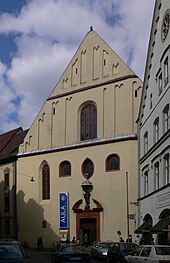Dominican monastery in Bamberg
The Dominican monastery in Bamberg is a former Dominican monastery with a church in Bamberg . Today the state building authority is located in the monastery wing , the church is used as the auditorium of the University of Bamberg .
As part of the renovation of the interior of the auditorium in 2013, the 25 newly designed windows were realized according to designs by the glass designer Günter Grohs from Wernigerode. They are the result of an artist competition with international participation and were carried out in cooperation with the Derix Glasstudios .
The beer garden of the neighboring Schlenkerla brewery is located in the former cloister courtyard .
history
Bishop Wulfing von Stubenberg (ruled 1304–1318), who came from Lavant to Bamberg in 1304 and was a member of the Dominican order, brought the order to Bamberg. The first settlement was in the area of the Nikolauskapelle at today's Maximiliansplatz. In 1310 the order received permission to build a monastery. After the purchase of land in the 17th century, the area of the Dominican monastery reached its still recognizable size.
church
The church was built before 1400 and was consecrated by Auxiliary Bishop Johann von Heldritt on November 5, 1400. The tomb of the auxiliary bishop, who died in 1416, is still in the church.
In the middle of the 17th century massive interventions were carried out, for example the rood screen was broken off. In the 18th century it was refurbished in a baroque style.
Cloister
The cloister was built during the reign of Prince-Bishop Georg I von Schaumberg (1459–1475), and its coat of arms adorns a keystone. Dendrochronological studies indicate that the trees for the entablature were felled between 1460 and 1463. In the cloister there are 42 grave slabs of deceased members of the order.
Monastery buildings
The large building facing the Regnitz began in 1730. The planning is possibly based on Balthasar Neumann , who was commissioned by Prince-Bishop Friedrich Karl von Schönborn to deliver a crack. Justus Heinrich Dientzenhofer was responsible for the execution . The foundation stone was laid in 1732 and the roof scaffolding was erected in the same year. The building was habitable in 1734, although further construction work continued until 1743. The artistic decoration was in the hands of the plasterer Franz Jakob Vogel , the ceiling paintings were created by Johann Jakob Gebhardt .
After the secularization of the monastery, the monks could live there until 1806. Even before the monastery was closed, the Bavarian state administration demanded that the buildings be released for the military. From the end of April 1804 were the military Aerar referred to the arrangement, the building sparingly as barracks remodel. A military hospital was set up for French troops in 1806 . It was not until 1912 that it was abandoned as a barracks. After the First World War, part of the monastery was sold to the owner of the neighboring Schlenkerla . He restored the Dominican hermitage from the 14th century with its Gothic vault and incorporated it into the historic restaurant.
In 1947 the Bavarian state signed a lease with the archbishop's chair. The archbishopric had the church set up as a home for the Bamberg Symphony Orchestra and opened the cultural space on June 17, 1950. In 1972 the city entered into the lease, which expired at the end of 1993. Today the church is used as the auditorium of the University of Bamberg . The Schlenkerla's beer garden is located in the Dominikanerhof.
For the convent buildings , planning began in 1976 to accommodate state authorities; the renovations were carried out from 1979 to 1982. In 1985 state offices could move in. The restoration of the library hall dragged on until 1987. Rich stucco work and ceiling paintings were uncovered. The middle picture represents an allegory of the Theologia sacra with St. Thomas Aquinas .
Whereabouts of the church property
Most of the interior furnishings came to the parish church of Hollfeld . The Evangelical Lutheran congregation of Heiligenstadt in Upper Franconia bought the organ prospectus for the church there.
The grave monuments in the church were destroyed except for a few. Some were returned to the von Schrottenberg family on Reichmannsdorf, others are in the Altenburg chapel, consecrated in 1835 .
literature
- Schlenkerla Dominikanerhof. In: The art monuments of Bavaria . Volume VI / 1, p. 390 ff. (Excerpt online)
Web links
Coordinates: 49 ° 53 '32.4 " N , 10 ° 53' 5.8" E


